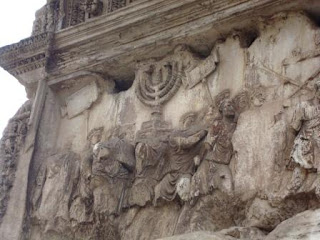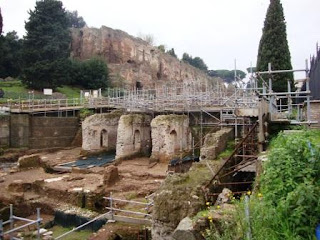It pretty much goes without saying that any trip to Rome and perhaps even to all of Italy isn't complete without a visit to the Roman Forum. The forum was the focal point of life as a citizen. That was where temples as well as civic buildings stood and where every important occasion was marked. The original forum became so crowded that later rulers built their own forums adjacent to it, such as Trajan's Forum.
Romans throughout the ages have had an interesting relationship with their architecture. It was quite common for one ruler to tear down buildings or monuments dedicated to other rulers and to reuse the materials in their own creations. Or, if they needed the land and had no concern for the previous use, they simply leveled it into a pile of rubble and built on top of it. Imagine Rome of a hundred and fifty years ago. The forum area was used to graze sheep and all that was visible was the top of the highest features around poking up from the ground. In excavating the area which is now the archeological site, they had to make a conscious decision about how far back to scrape away, ending up some 20 feet below the current surrounding level of Rome. Even as little as a few decades ago, Mussolini created the Via dei Fori Imperiali by blacktopping a stip from the new Victor Emmanuel monument to the old forum with little regard to what else he might have been compromising. In a swing the other direction, modern Rome's attempts to create a comprehensive subway system have been stiffled at every turn by their recognition that they must preserve their heritage as they dig through the layers.
For many years, the forum was free to visitors. There were still only a few entrances since much of the excavation is significantly below ground level. A couple of years ago they fenced the entire perimeter and instituted a fee for entry in order to help with the costs of preserving the area. Below is the view as you enter through the main gate.
One result is that many places you could wander and/or climb have now been placed off limits. I noticed this even across the 15 years since I first visited. One example is the Basilica Julia to your right as you enter. Where before you could wander, now there are fences.
One of the favorite places for visitors is the Temple to Caesar. Many mistakenly think that this marks the location of Caesar's murder. Rather, the temple was built on the site of his cremated remains. Visitors leave flowers year round with many more on the Ides of March.
One benefit of the admission fee is that the forum is now used for educational exhibits. This fall they had a major overview of Emperor Nero, he of the fiddling while Rome was burning. It was housed primarily in the original Roman senate house. Below is a frieze that would have adorned an altar on which animal sacrifices were offered.
A surprisingly large number of busts of Nero have survived. I say surprising because he was NOT beloved by the people and, upon his death, much of what he had built was demolished. There were apparently four major types of Nero figures. Some of them are illustrated below. In the right foreground is an obvious adolescent. In the background, also to the right, is a bust in the Hellenistic style. The features of that bust are quite interesting because after Nero's death it was refashioned into the bust of another emperor and then a few hundred years later converted back to being Nero.
A second advantage of the entry fee is that they have been opening parts of the forum that were not previously accessible. That is the case with the area dedicated to Vesta. Below is the courtyard of the House of the Vestals. There were six Vestal Virgins. Girls between the ages of 6 and 10 were chosen from prominent families to be keepers of the sacred fire of Rome. They spent a total of 30 years in service to Vesta: 10 years in training, 10 years as keepers of the flame, and 10 years training another generation of girls. As reward for their service, they were very well provided for and were accorded many rights not usually given to women such as the right to own property without a male guardian. They were required to be celibate during their 30 years of service, thus the virgin part, but were allowed to do as they pleased, including marry, once their time was up. Below is the courtyard of their compound.
It was ringed by statues, now and in ancient times, which were effectively the Vestal Virgin Hall of Fame.
They had a separate enclosure at the end of the courtyard with individual chambers.
Another interesting feature of the forum are the arches. These triumphal monuments were built at various entrances to the forum. Below is the Arch of Titus.
It is known for its depiction of the Sack of Jerusulem. Note the soldiers carrying away the menorah from the temple in the frieze below.
Another area undergoing extensive exploration is at the side of the forum facing the Colosseum where they are excavating the site of some Roman warehouses.











No comments:
Post a Comment